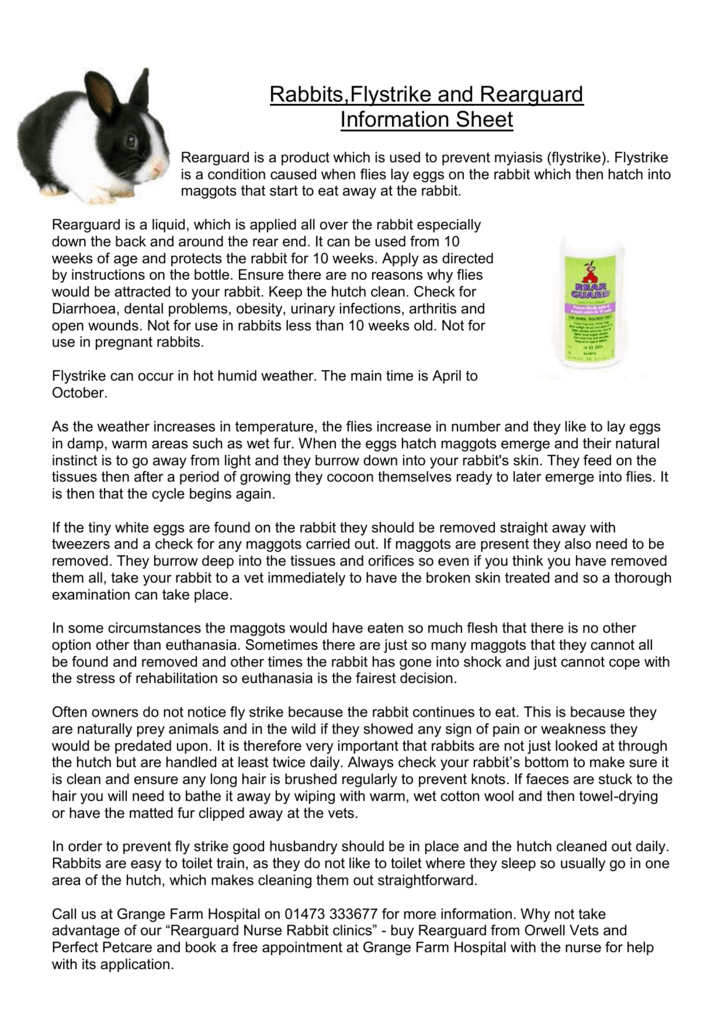
You can also put up fly screens around your rabbit's hutch and growing plants and herbs, i.e rosemary, peppermint, basil and green oregano will repel flies. It is vital that owners clean their rabbit's bedding regularly.
#Bunny fly strike skin
Symptoms of fly strike include listlessness, itchy, irritated skin and, in some cases. The larvae burrow into the flesh, producing toxins that can induce of state of shock in the rabbit. Flies lay their eggs in open sores on a rabbit or on skin dampened with feces or urine. A fly can lay up to 200 eggs on your rabbit. Moisture, blood, urine, and faeces attract flies, so if your rabbit has difficulty keeping clean and dry due to injury, age, or physical condition, it could be more at risk. Protection with a topical treatment will typically last for 8-10 weeks.Īnother common cause of flystrike in rabbits is housing them in unsanitary hutches. An infestation of fly larvae, or maggots, in the skin of a rabbit. Some rabbits are more prone to fly strike than others. You can also use a topical product containing an ingredient called 'cyromazine' as it is highly effective in preventing fly eggs from hatching. We advise to check your rabbits bottom at least twice a day, and if you notice a dirt build up, wash the area with warm water and a shampoo specifically designed for small animals, before rinsing and thoroughly drying. Keep the plants out of reach of your rabbit so they cannot eat them.Rabbits who struggle to groom themselves, due to long fur, obesity, painful teeth or arthritis are at greater risk of flystrike as green bottles are attracted to areas soiled with faeces and urine and it only takes a small amount of soiling for flies to strike. As well as this there are some natural products that help keep the flies away such as, basil, bay leaf, lavender and mint, these can be hung in dried bunches around the hutch. To prevent your rabbit from getting fly strike, check it twice a day during warm and hot weather for fly eggs and maggots. There are products you can get to help prevent flystrike, such as fly netting and flypaper around the hutch or cage, however if you are using these you must take care so that your rabbit doesn’t get tangled or injured by them. When attracted to the rabbit by certain conditions, flies will lay their eggs on the rabbit, which subsequently hatch into maggots (larvae). If the rabbit isn’t treated immediately, it can unfortunately become fatal. Myiasis, or fly strike, is unfortunately a common problem with domestic rabbits, often with severe consequences. They can eat into your rabbit’s flesh within 24 hours which can cause death in a very short time. Maggots from blowflies: bluebottles and green bottles, are the most dangerous. Alongside this an anti-parasitic drug is used to help ensure that all remaining maggots and eggs are killed. It happens when flies lay their eggs on your rabbit, and those eggs hatch out into maggots. Rabbits with flystrike will be in a lot of pain and shock so it is important for an experienced vet to deal with the situation.The vet will also recommend antiseptic creams to be applied to the wound several times a day. If not treated in time by an experienced veterinarian, the bunny suffering from a Bot Fly strike will likely die. This may need to be done under general anaesthetic. The vet will usually shave the area, remove all maggots and give pain relief. If you do spot any maggots you will need to get your rabbit to the vets immediately. If your rabbit seems subdued, quiet, restless or is in any discomfit you should pick them up immediately and check for eggs and maggots. This is a horrible disease, as these maggots then eat. It is also important to remove any droppings or urine from the hutch every day to help prevent the flies. Flystrike occurs when certain types of fly lay their eggs on a rabbit, which then hatch into maggots. Flystrike is most common in summer months when the weather is warmer, your rabbit should be checked at least twice a day as flystrike can become deadly in as little as a couple of hours. Fly Strike can happen anywhere and anytime when weather is warm enough to hatch fly eggs. Furthermore, if your rabbit has an unsuitable diet which leads to loose stools this will attract flies and make it difficult for your rabbit to keep clean.Īlthough flystrike often occurs on the rabbit’s bottom it can happen anywhere on the rabbit’s body, especially if they have an open cut or wound, so checking your rabbit and treating any injuries quickly is extremely important. If your rabbit has bad teeth, is old or has arthritis it may find it difficult to clean itself.

This is very painful for the rabbit and be fatal if not caught and treated early.Īny rabbit can get flystrike, but it is most common in rabbits with dirty bottoms, wet fur, wounds or if they are unable to clean themselves properly.

Flystrike is a condition caused by flies laying eggs on the rabbit, which then hatch into maggots and eat the rabbit’s flesh.


 0 kommentar(er)
0 kommentar(er)
